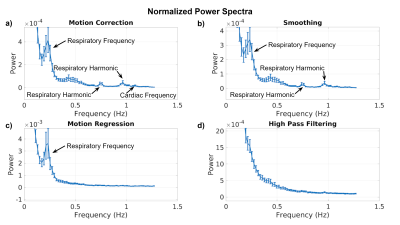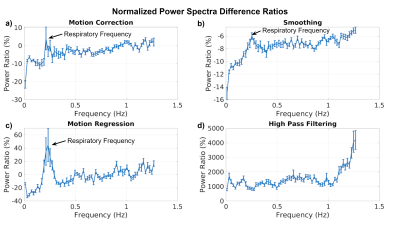Jacob J.L. Matthews1, Jillian Krotz1, and J. Jean Chen1,2
1Rotman Research Institute, Baycrest, Toronto, ON, Canada, 2Medical Biophysics, University of Toronto, Toronto, ON, Canada
1Rotman Research Institute, Baycrest, Toronto, ON, Canada, 2Medical Biophysics, University of Toronto, Toronto, ON, Canada
We demonstrate that commonly used preprocessing steps each alter the resting-state fMRI signal in a unique way, modifying the cardiac and respiratory noise before physiological denoising is even applied.

Figure 1. Normalized Fourier power spectra. Normalized Fourier power spectra calculated after each preprocessing step. Values have been binned and averaged across subjects. Error bars represent standard error across subjects. a) Motion Correction: Respiratory frequency, respiratory harmonics, and cardiac frequency labelled, b) Smoothing: Respiratory frequency, and respiratory harmonics labelled, c) Motion Regression: Respiratory frequency labelled, d) High Pass Filtering: no visible physiological frequency peaks.

Figure 2. Normalized Power Spectra Difference Ratios. Normalized Fourier power spectrum difference ratios expressed as a percent change. Values have been binned and averaged across subjects. Error bars represent standard error across subjects. a) Motion Correction: Respiratory frequency labelled, b) Smoothing: Respiratory frequency labelled, c) Motion Regression: Respiratory frequency labelled, d) High Pass Filtering: no visible physiological frequency peaks.